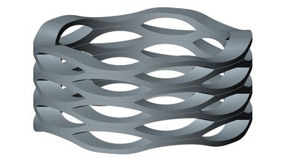Wave springs
Contents |
[edit] Introduction
Wave springs are some of the most widely used types of springs, but often, we don’t even realise that we are using them.
Most commonly found in circumstances where space is limited, wave springs are essential to many components in the world of mechanical design. They must be compact, provide ample force and be able to withstand immense pressure over a long period of time to be effective.
[edit] What are wave springs?
Wave springs are a type of compression spring made from flat wire. They are called wave springs as they have multiple waves per turn. The flat wire, along with multiple waves, combine to create the same amount of force at reduced work heights when compared with other types of springs.
With technological developments meaning that many devices that once used compression springs have shrunk in size, the need for smaller, more compact springs has grown. The reduced size has allowed engineers to reduce the spring cavity once common in many technologies.
Wave springs are designed bespoke dependent on a spring force vs. work height ratio.
[edit] How are wave springs made?
In a similar method to many other types of spring, flat wire is passed through a specially-calibrated machine where it coils and ‘bounces,’ resulting in a wave spring. The machine is set up to process the wire up to a certain length, providing a system that can be tailored to any given project or requirement, and reducing waste.
Whilst wave springs can be made from a variety of materials, including carbon and stainless steel, they require fewer materials to compose, resulting in more cost-effective production.
[edit] Properties of wave springs
Wave springs are versatile; they hold many advantages that maintain their popularity with designers. For example, where space is limited, the innovative design of the wave spring ensures that the same amount of force as a compression spring is produced at 50% of the operating height.
Due to the layered design, only one spring is needed, whereas with alternative springs, such as stacked disc springs, several are needed to provide the same effect. In addition, the design of the spring can be amended to reflect whatever the task requires. For example, factors such as wire size, wire form and the turn configuration can all be altered to ensure that the end result is fit for purpose.
[edit] Common uses of wave springs
Due to the fact that wave springs can be substituted for compression springs, they are regularly used in a number of daily item:
- Trainers
- Door locks
- Suspension systems
- Robotics
- Mechanical equipment
- Technological devices
- Medical products
- The oil and gas Industry
[edit] Related articles on Designing Buildings Wiki
- Compression springs.
- Die springs.
- E-spring.
- Flat springs.
- Key qualities of springs.
- Large and Hot Coiled Compression Springs
- Spring materials.
- Tension springs v torsion springs.
- The Difference Between Tension and Torsion Springs
- The importance of gas springs.
- The Multiple Uses of Compression Springs
- The Uses of Wire Forms Within the Construction Industry.
- Types of spring.
- Using springs in construction to prevent disaster.
Featured articles and news
Infrastructure that connect the physical and digital domains.
Harnessing robotics and AI in challenging environments
The key to nuclear decommissioning and fusion engineering.
BSRIA announces Lisa Ashworth as new CEO
Tasked with furthering BSRIA’s impressive growth ambitions.
Public buildings get half a million energy efficiency boost
£557 million to switch to cleaner heating and save on energy.
CIOB launches pre-election manifesto
Outlining potential future policies for the next government.
Grenfell Tower Inquiry announcement
Phase 2 hearings come to a close and the final report due in September.
Progress from Parts L, F and O: A whitepaper, one year on.
A replicated study to understand the opinion of practitioners.
ECA announces new president 2024
Electrical engineer and business leader Stuart Smith.
A distinct type of countryside that should be celebrated.
Should Part O be extended to existing buildings?
EAC brands heatwave adaptation a missed opportunity.
Definition of Statutory in workplace and facilities management
Established by IWFM, BESA, CIBSE and BSRIA.
Tackling the transition from traditional heating systems
59% lack the necessary information and confidence to switch.
The general election and the construction industry
As PM, Rishi Sunak announces July 4 date for an election.
Eco apprenticeships continue help grow green workforce
A year after being recognised at the King's coronation.
Permitted development rights for agricultural buildings
The changes coming into effect as of May 21, 2024.






















